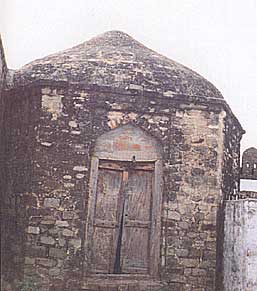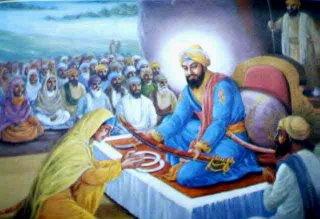Mata Sahib Kaur
Mata Sahib Kaur
Mata Sahib Kaur ji is known as the "Mother of the Khalsa". She earned the distinction by instilling the first Amrit with the sweetness that balances its fierceness. Mata Sundari ji (also known as 'Mata Jito ji') was the only wife of Guru Gobind Singh. Mata Sahib Kaur Ji, who was called 'Sahib Devan' before recieving Amrit, was the Spiritual Mother of the Khalsa, however some historians have mistakenly confused Mata Sahib Kaur ji as having been married to Guru Gobind Singh ji.
Mata Sahib Devan's father wished her daughter to marry Guru Gobind Singh, however as the Guru was already married, her father asked the Guru's permission for Mata Sahib Devan to live in the Guru's house as Sikh and serve the Guru and his family. Therefore, Mata Sahib Devan was never married and never had a physical relationship with the Guru. As a consequence of not marrying Mata Sahib Devan and her not being able to have children, Guru Gobind Singh made her the "Mother of the Khalsa". Up to this day in history, all Sikhs who take Amrit consider Mata Sahib Kaur as their (spiritual) Mother, and Guru Gobind Singh ji as their (spiritual) Father.
MOTHER OF KHALSA - MATA SAHIB KAUR JI
From Manvir Singh's blogspot (www.manvirsingh.blogspot.com)
In Sikh history Mata Sahib Kaur is known as the Mother of the Khalsa. This honour was bestowed upon her by the Tenth Nanak, Guru Gobind Singh Ji. When a Sikh recieves the gift of Khande Dee Pauhul (Amrit), he/she is told that from today onward your father is Guru Gobind Singh Ji and you mother is Mata Sahib Kaur Ji.
Mata Sahib Kaur Ji, whose name before taking Amrit was Mata Sahib Devan Ji, was born on the 1st November 1681 in a village called Rohtas, District Jehlum, in West Panjab, (now in Pakistan). Her mother’s name was Mata Jasdevi Ji and father’s name was Bhai Rama Ji. Her father, who was an ardent sewak (devotee) of Guru Gobind Singh Ji, influenced her to the extent that she wanted to devote her whole life in the service of the Guru Sahib. From her childhood, Mata Sahib Kaur Ji was a sweet and quiet natured girl. Because of the religious atmosphere at home, she was deeply influenced by Gurbaani during her formative years. It is possible that in her childhood she might have seen Guru Gobind Singh Ji at Sri Anandpur Sahib during the visit of her family. She had inherited humility, love and sacrifice to humanity and devotion to Waheguru.

Birth house of Mata Sahib Devan at Rohtas, Jhelum
When she came of age, her father and other devotees of village Rohtas, took her to Sri Anandpur Sahib and requested Guru Gobind Singh Ji to take her as his bride. Guru Ji told the Sangat that he was already married and could not marry again. However, Mata Sahib Kaur Ji's father had pledged his daughter to Guru Sahib and no-one else would marry her now. Therefore, Guru Sahib agreed that Mata Sahib Kaur Ji could stay with the Guru's family, however, they could not marry or ever have children. Guru Sahib instead promised Mata Sahib Kaur Ji, that you will become a great Mother to thousands. Mata Sahib Kaur Ji lived in the Guru's household and served Guru Ji and the Sangat with full shardaa (devotion).

Mata Sahib Kaur Ji accompanied Guru Sahib throughout his life, even during battles, serving him in every possible way. On Vaisakhi 1699, in the first Amrit-Sanchaar, Mata Sahib Kaur Ji participated in the sewa of the Amrit-Sanchaar by adding Pataasey (sugar wafers) to the Amrit, and was bestowed the honour of eternal motherhood of Khalsa Panth.

Mata Ji guided the Khalsa Panth through period of crisis many times and issued eight decrees in the name of Khalsa.

When Guru Gobind Singh reached Abchal Nagar (Sri Hazoor Sahib), he sent Mata Sahib Kaur Ji to Delhi and gave her five weapons of the Sixth Nanak, Guru Hargobind Sahib Ji, for safekeeping. These weapons are today displayed at Gurdwara Rakabganj in Delhi. Mata Sahib Kaur Ji, passed away before Mata Sundri Ji. She left for heavenly abode at the age of sixty six in 1747 and her last rites were performed in Bala Sahib, Delhi.

Gurdwara Bala Sahib, Delhi
www.manvirsingh.blogspot.com
Why did Guru Gobind Singh have more than one wife?
How many marriages did Guru Gobind Singh have?
The wrong impression that the Guru had more than one wife was created by those writers who were ignorant of Punjabi culture. Later authors accepted those writings indicating more than one marriage of the Guru and presented it as a royal act. During those days kings, chiefs, and other important people usually had more than one wife as a symbol of their being great and superior to the common man. Guru Gobind Singh, being a true king, was justified in their eyes to have had more than one wife. This is actually incorrect. In Punjab, there are two and sometimes three big functions connected with marriage, i.e., engagement, wedding, and Muklawa. Big gatherings and singings are held at all these three functions. In many cases, the engagement was held as soon as the person had passed the infant stage. Even today engagements at 8 to 12 years of age are not uncommon in some interior parts of India. The wedding is performed a couple of years after the engagement. After the wedding, it takes another couple of years for the bride to move in with her in laws and live there. This is called Muklawa. A dowry and other gifts to the bride are usually given at this time of this ceremony to help her to establish a new home. Now, the wedding and Muklawa are performed on the same day and only when the partners are adults. A big befitting function and other joyful activities were held at Anand Pur, according to custom, at the time of the engagement of the Guru. The bride, Mata Jeeto Ji, resided at Lahore, which was the capital of the Mughal rulers who were not on good terms with the Gurus. When the time for the marriage ceremony came, it was not considered desirable for the Guru to go to Lahore, along with the armed Sikhs in large numbers. Furthermore, it would involve a lot of traveling and huge expenses, in addition to the inconvenience to the Sangat, younger and old, who wished to witness the marriage of the Guru. Therefore, as mentioned in the Sikh chronicles, Lahore was 'brought' to Anand Pur Sahib for the marriage instead of the Guru going to Lahore. A scenic place a couple of miles to the north of Anand Pur was developed into a nice camp for the marriage. This place was named Guru Ka Lahore. Today, people are going to Anand Pur visit this place as well. The bride was brought to this place by her parents and the marriage was celebrated with a very huge gathering attending the ceremony.
The two elaborate functions, one at the time of engagement and the other at the time of the marriage of the Guru, gave the outside observers the impression of two marriages. They had reason to assume this because a second name was also there, i.e., Mata Sundari Ji. After the marriage, there is a custom in the Panjab of giving a new affectionate name to the
bride by her inlaws. Mata Jeeto Ji, because of her fine features and good looks, was named Sundari (beautiful) by the Guru's mother. The two names and two functions gave a basis for outsiders to believe that the Guru had two wives. In fact, the Guru had one wife with two names as explained above.
Some historians even say that Guru Gobind Singh had a third wife, Mata Sahib Kaur. In
1699, the Guru asked her to put patasas (puffed sugar) in the water for preparing Amrit when he founded the Khalsa Panth. Whereas Guru Gobind Singh is recognized as the spiritual father of the Khalsa, Mata Sahib Kaur is recognized as the spiritual mother of the Khalsa.
People not conversant with the Amrit ceremony mistakenly assume that Mata Sahib Kaur was the wife of Guru Gobind Singh. As Guru Gobind Singh is the spiritual but not the biological father of the Khalsa, Mata Sahib Devan is the spiritual mother of the Khalsa, Mata Sahib Devan is the spiritual mother of the Khalsa but not the wife of Guru Gobind Singh.
From ignorance of Punjabi culture and the Amrit ceremony, some writers mistook these three names of the women in the life of Guru Gobind Singh as the names of his three wives. Another reason for this misunderstanding is that the parents of Mata Sahib Devan, as some Sikh chronicles have mentioned, had decided to marry her to Guru Gobind Singh. When the
proposal was brought for discussion to Anandpur, the Guru had already been married. Therefore, the Guru said that he could not have another wife since he was already married. The dilemma before the parents of the girl was that, the proposal having become public, no
Sikh would be willing to marry her. The Guru agreed for her to stay at Anand Pur but without accepting her as his wife.
The question arose, as most women desire to have children, how could she have one without being married. The Guru told, "She will be the "mother" of a great son who will live forever and be known all over the world." The people understood the hidden meaning of his
statement only after the Guru associated Mata Sahib Devan with preparing Amrit by bringing patasas. It is, therefore, out of ignorance that some writers consider Mata Sahib Devan as the worldly wife of Guru Gobind Singh.
